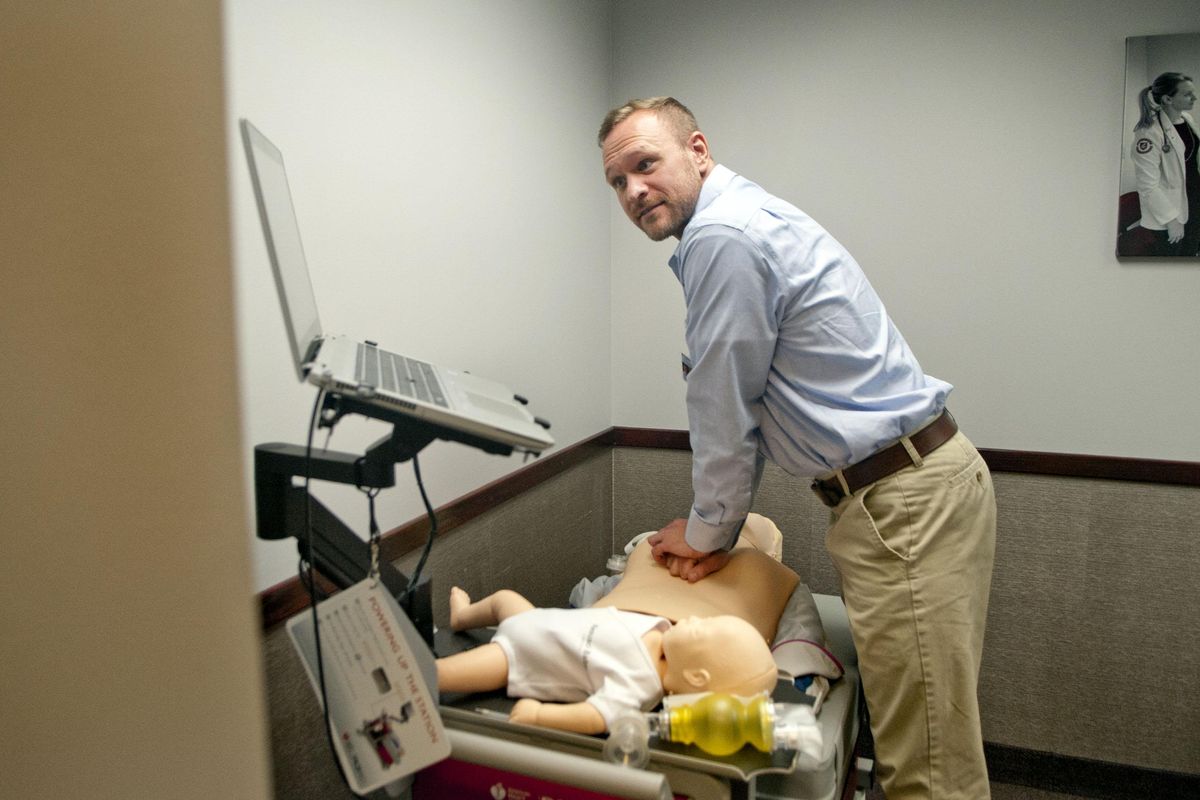WSU Medical School offers students enhanced CPR training

During his first week back at the WSU College of Medicine this year, Michael Durrant went to a CPR class with other students. Little did he know that he would use his skills almost immediately. He was out shopping with his kids that same week, when a man collapsed right next to them, he said.
Using his training, Durrant was able to perform CPR, and the man was eventually saved. Durrant and other third-year medical students will continue CPR training throughout the duration of their studies at the WSU College of Medicine, using the Resuscitation Quality Improvement 2020 program, an enhanced CPR learning model, which requires students to do in-person tests every 90 days.
Starting this fall, WSU is the first medical school to use RQI 2020 in its program, although the technology is used in hospitals and clinics to train medical professionals around the country. The program differs from a traditional CPR course, which typically lasts several hours in a single-day session, which then results in a certification good for two years.
Students must complete online training courses and then every 90 days do an in-person training in the simulation lab, where they perform compressions and ventilation on an adult and then an infant mannequin. The mannequins are incredibly sensitive, measuring compressions down to a tenth of a millimeter.
Durrant came into the simulation lab for his 90-day checkup test on Wednesday. After entering his information, the machine began to talk to him: “Move hands to chest.” “Pump slower.” He continued to compress the mannequin’s chest in a rhythm until the machine agreed the pace was right. “Good.” “Very good,” the machine chirped.
After about a minute, Durrant’s score popped up. He passed. Next was ventilation.
The RQI 2020 is measuring not only the number of compressions but also hand placement and recoil as well as depth and rate of compressions, said Chris Martin, director of simulation-based training.
“We can see exactly what areas the students are struggling with, which can include if they are ventilating too fast, or too slow,” Martin said. “Are they not placing their hands right? We can dial in and provide targeted skills development to something very specific and give them actionable feedback items with a very small degree of subjectivity.”
The program tracks each student’s progress. When it comes to resuscitation, compressions are incredibly important, Martin said, and with a program like RQI 2020, students can sharpen their skills on a quarterly basis instead of getting the certification and not practicing for another two years.
“The data shows that the best chance for outcome in cardiac arrest, whether it be in hospital or out of hospital, is high-quality CPR is what is saving lives – period,” Martin said. “So by reinforcing such a basic skill, it provides the method or the pathway to which we can save more lives.
Durrant, who worked in a hospital before entering medical school, has given CPR seven times in his life, with success four times. He said the training is useful to keep his skills fresh and to keep doubts at bay in crisis situations when he has been called on to perform CPR.
“When you do CPR, in the back of your mind, you’re thinking, am I doing this right, and you don’t want to be thinking that,” he said.
Once Durrant passed his adult compression and ventilation, he had to perform infant CPR. Using two fingers, he made smaller compressions into the tiny mannequin’s chest.
“Compress more often.” “Go deeper,” the machine said. The instantaneous feedback helped him correct his compressions, and in the end he passed that test, too. Martin said no student can fail in the model, and if they do not perform to a high enough standard, despite the program’s verbal corrections, they can try again. The point, he said, is that it is meant to encourage higher-quality performance.
WSU has the RQI 2020 program in Spokane as well as in a mobile unit, which rotates among Everett, Vancouver and Tri-Cities WSU campuses. Durrant finished his in-person test in less than 10 minutes, and he would complete a similarly short simluation course later in order to complete his 90-day check-in.
The CPR training is a part of the medical school program, required of all third- and eventually fourth-year medical students at WSU. The training will prepare students for hospital settings as well as rural settings.
“I think by exposing our students to the research-based approach to CPR and showing them outcomes associated with it, when they go to those rural communities, the knowledge that they’ve taken from this program will be brought to there,” Martin said.